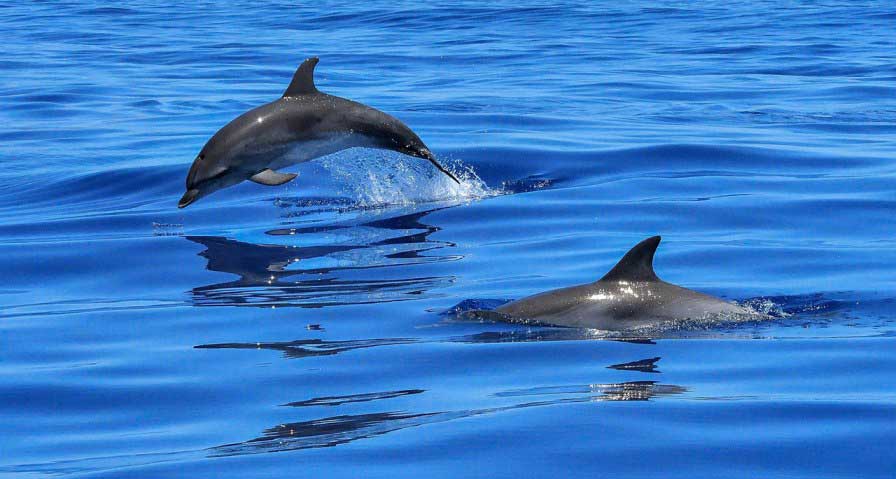German zoologists have found that bottlenose dolphins are as good as sharks and other fish in their ability to sense very weak electric fields, which allows these cetaceans to use the Earth’s magnetic field for orientation in space. Underwater compasses have recorded disturbances in the Earth’s magnetic field deep under water.
The ability to sense even very weak electric fields allows dolphins to search for fish hidden on the seabed under a layer of sediment. In addition, the presence of such an ability in cetaceans explains why toothed whales move along the Earth’s magnetic field lines during migrations. As TASS reports, the scientists’ findings were published in an article in the scientific journal Journal of Experimental Biology.
A group of biologists from the University of Rostock (Germany) has been studying the ability of marine mammals to sense alternating and constant electric fields for more than 10 years. During this time, they have discovered the presence of such a skill in two species of warm-blooded marine animals, bottlenose dolphins (Tursiops truncatus) and Guyana dolphins (Sotalia guianensis).

The discovery of this ability in several species of cetaceans at once made scientists wonder how dolphins use this sense and how well their ability to sense electric fields is developed compared to sharks and other fish that also have this skill. To obtain such data, biologists created a special setup that allowed them to track the reaction of two bottlenose dolphins, Dolly and Donna, to electric fields.
Scientists taught the animals to react to the appearance of these fields as quickly as possible, for which the experimenters gave the animals additional portions of food. Measurements taken by the researchers showed that both dolphins recognized even very weak constant magnetic fields, whose intensity was only 5 μV per cm, as well as fairly weak alternating fields (11–29 μV per cm).
According to biologists, this makes them comparable in this respect to sharks, and also allows dolphins to sense the Earth’s magnetic field when moving quickly enough through the water column. In addition, the ability to sense electric fields should help dolphins search for fish in the near-surface layers of sediment on the seabed, where the work of their “echolocators” is difficult, the researchers concluded.
Many biologists today consider dolphins to be among the most highly developed mammals on Earth, which are not inferior in the level of intellectual development to the higher primates. In recent years, scientists have found a lot of evidence that these cetaceans are able to recognize themselves in the mirror, use tools, pass on their skills to their relatives, coordinate their actions and experience emotions that were previously considered an exclusive feature of humans.
The solar storm of May 2024 was strong enough to cause disturbances in the deepest ocean. Underwater compasses deep under the sea recorded disturbances in the Earth’s magnetic field.
The deep sea may be pitch black, but the sun still shines down. During the solar storms of May 2024, the ones that lit up half the planet with auroras, Ocean Networks Canada (ONC) deep-sea observatories detected disturbances in the Earth’s magnetic field.
ONC observatories range from the Arctic to Antarctica and have more than 12,000 sensors recording data, including compasses used to measure ocean currents. In tandem with this month’s explosive solar activity, the compasses recorded significant anomalies — sharp shifts in the Earth’s magnetic field. One compass at the NEPTUNE Observatory near Vancouver Island changed direction between +30 and -30 degrees.

Northern Lights over the ocean. Tolstnev
It wasn’t the first time the team had seen solar anomalies in the underwater compass readings. In late March, while performing routine quality checks, ONC data scientist Alex Slonimer noticed the same magnetic field fluctuations in the data, albeit on a smaller scale.
“I checked to see if it was potentially an earthquake, but that didn’t make much sense because the changes in the data were too long and in different places at the same time,” Slonimer said in a statement. “Then I checked to see if it was a solar flare, since the sun has been active lately.”
Indeed, solar activity was the one that affected the compasses underwater — some of which are located 1.7 miles (2.7 kilometers) below the surface. Similar anomalies, which coincided with solar storms in May 2024, further strengthened the oscillations’ connection to the sun.
“The range of these data records in kilometers below the ocean’s surface highlights the scale of this past weekend’s solar flare and suggests that the data may be useful in better understanding the geographic scale and intensity of these storms,” ONC President and CEO Kate Moran said in a statement released May 15.




